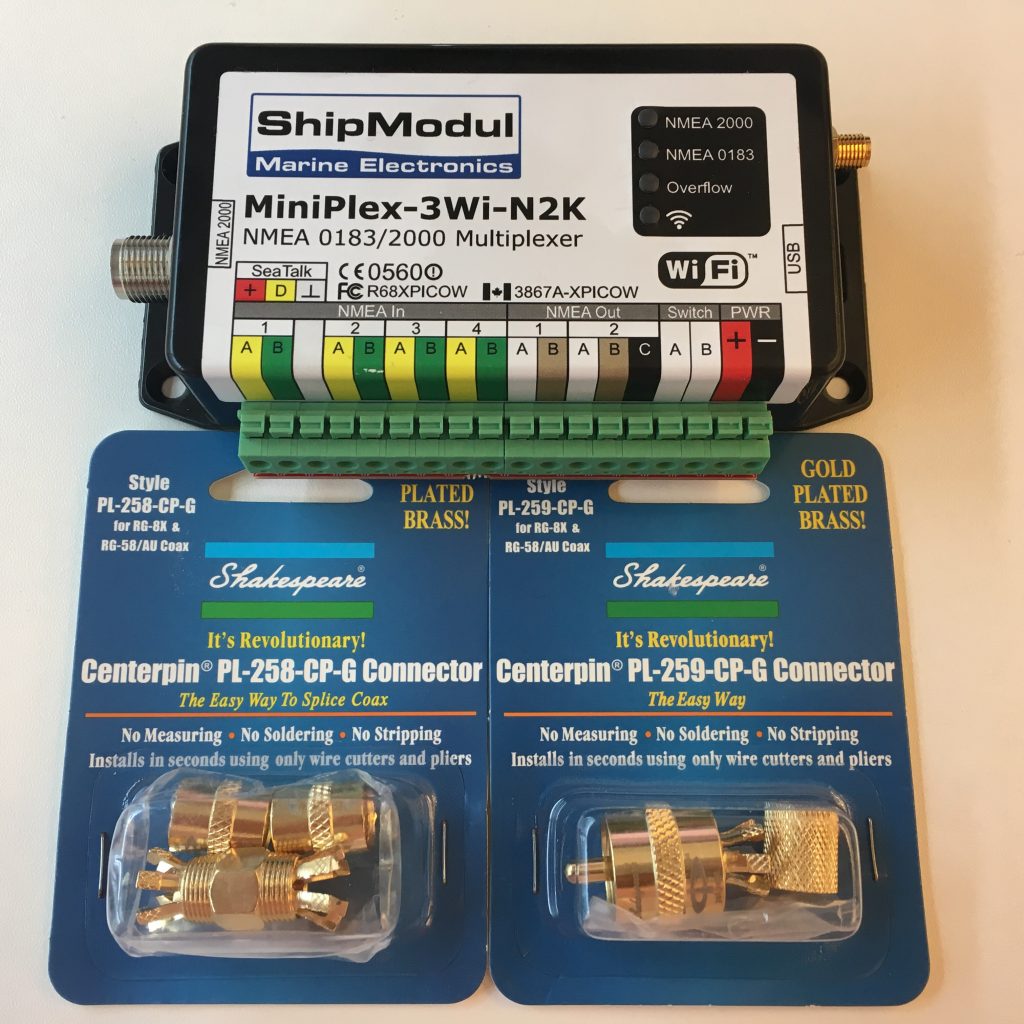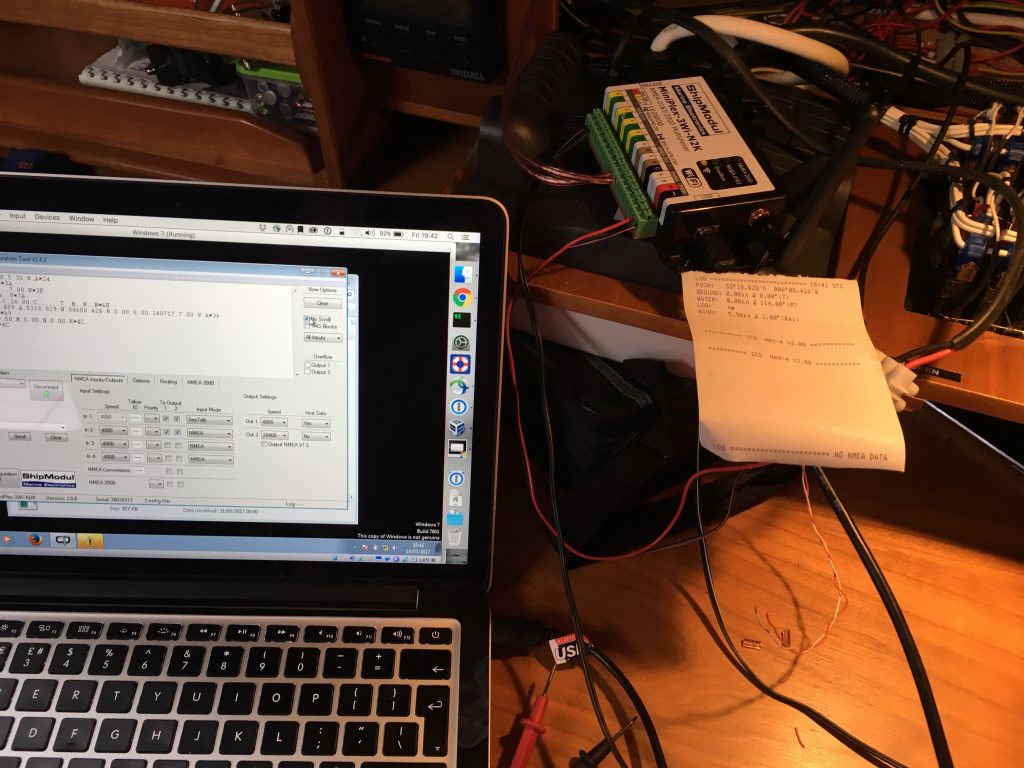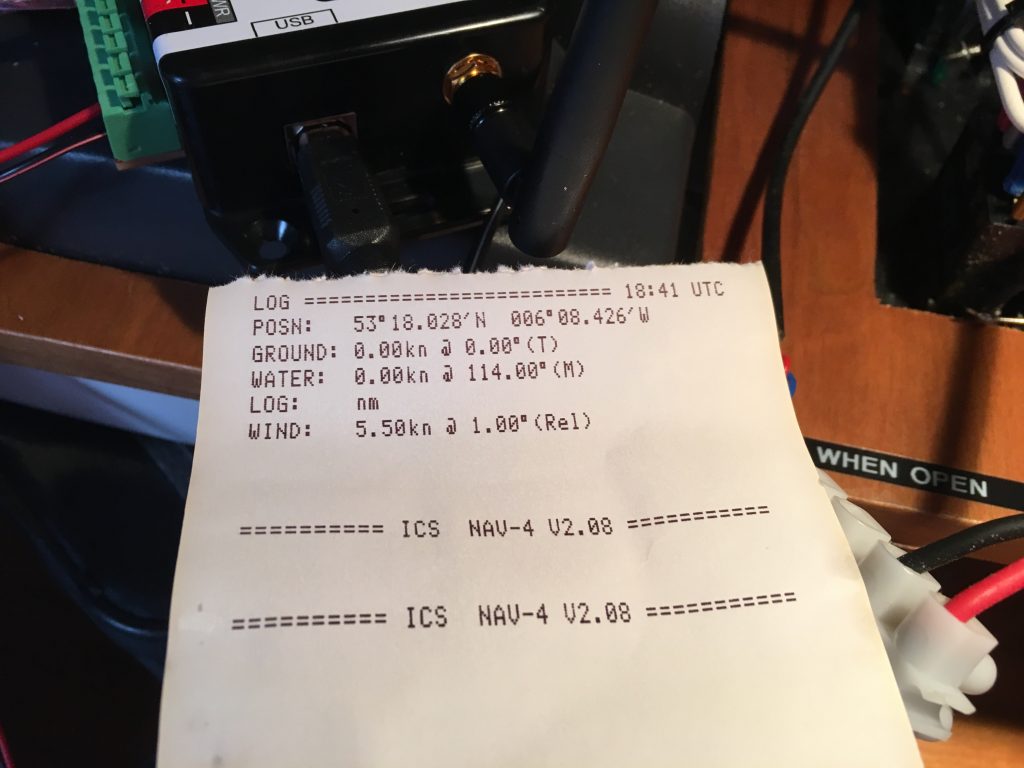While out sailing with my parents and K over the weekend just gone (sailing through three regatta fleets is fun!), Dad was working on hooking up the external speaker in Blue Opal‘s cockpit to the M323G radio. We had the handheld VHF turned on, and heard a broadcast on the the handheld that wasn’t audible on the fixed set; this should never happen, because the handheld only has the little rubber duck antenna, while the fixed set has a whip antenna at the top of the mast. It had also been remarked to me by at least one of the volunteer boatmen that they only heard me the second or third time I called them, and that the signal was pretty quiet.
Monday evening, I went out to Blue Opal to see what was up with the radio. The hypothesis was that there was a fault in either the PL-259 connecting to the radio, the join at the base of the mast, or the join to the antenna.
- Test one – continuity test across the PL-258 connector. Stuck a pin (well, a sailing needle) into the braid on each side of the join connector, and found I had continuity, so the braid was joined properly. That mostly eliminated a shielding issue.
- Test two – continuity test across the PL-259 connector. Found continuity; probably shouldn’t be any here.
- Test three – continuity test across the PL-259 connector on the emergency antenna. No continuity, so test two is supicious.
- Test four – dismantle the PL-258 connector on the radio side of the join, and test for continuity across the core and shield going to the antenna. No continuity; the antenna is good. Put the PL258 back together.
- Test five – cut the PL-259 off in case it’s a bad soldering job. Test continuity on the shield and core. Continuity. This is where I made a mistake (and Dad didn’t pick up on it either – we were chatting over the phone as I did this work); I didn’t need to cut the PL-259, I could have left the cable disconnected at the PL-258 end, and tested continuity on the PL-259 to see if it was wired badly.
- Examine the PL-258 more carefully, and discover that some of the fangs have been crimped very hard. Used a small screwdriver to ease them out.
- Test six – test continuity on the shield and core. No continuity.
Conclusion: When the mast was put up in Conwy, and the cabling reconnected, the PL-258 was crimped too hard, and joined the braid to the core. This resulted in a shorted antenna, and I was only receiving and transmitting with the length of cable from the radio to the base of the mast, most of which is horizontal and below the waterline.
Ordered some replacement PL-259 and PL-258 bits from East Coast Marine, had them shipped via Parcel Motel in Belfast, and installed them today. I can now say that I appreciate how easy it is to get the crimping of the fangs wrong; it just takes a little too much pressure on the handle of the pliers and the fangs will sink through the plastic very quickly. Getting the knurled bits to thread over the threads on the connector was also a pain – there’s a little rim inside the knurled bit, and the fangs have to be crimped tight enough to fit inside that diameter, but not so tight as to bite all the way to the core.
The other work today was installing a ShipModul MiniPlex-3. We had intended to install it when my parents were visiting, but the wrong unit was sent (and this was rectified with a single email). With some fiddling, I managed to get an old handheld Garmin eTrex unit to send NMEA 0183 sentences to the unit, and I could see them going past in the console screen – this was also a bit of a yak-shaving exercise; my laptop is a work-issued Mac, and ShipModul’s client isn’t up to date for OS X, so I had to install the ShipModul driver in OS X, run a VirtualBox VM with Windows 7, and tell the VM to grab the USB device that allowed it to talk to the MiniPlex – worked just fine! Made a note of what wires went where, and went out to the boat to install it.
Pulled the Yeoman out, which freed up some power on a chocolate block connector (the Yeoman wasn’t reading leisure charts, and the manufacturer was unsure if they could repair it), hooked up the MiniPlex, hooked up the Garmin, hooked up the laptop, and … nada. Not a sausage. No data from the Garmin at all. Messed with this for a bit, and gave up. Wired in the SeaTalk connection instead (which was the goal, the Garmin was just a “known good” test (or not)), flicked the switch that turns on power to the Autohelm gear, and the console log for the MiniPlex started scrolling.
Next up, wire in the NavTex (which was one reason I wanted the MiniPlex, so I could get the SeaTalk GPS signal over to the NMEA input), turn it on, and presto – GPS logging, printed out. This means I can come on board, fire up all the electronics, and go sailing, and I’ll have a log of where I was.
Next projects:
- Install bigger busbars in the wiring space above the chart table. The existing ones are over-subscribed.
- Contemplate a Raspberry Pi rigged to read NMEA from one of the ShipModul’s output ports. One has been sent to the NavTex, so I’ve only got one other output I can use. Alternately, since this is the WiFi edition, I can just read the UDP packets from the wireless network, and log to an SD card. However, I then have to solve getting the logs off of the Pi.
- Consider black-box AIS instead of with-a-screen AIS. The ShipModul will let me integrate one that speaks NMEA2000, so I’m not locked to Raymarine’s SeaTalk1 offerings (which is the main bus on Blue Opal).
- Work out whether to get a chart plotter, or go the tablet route, given the ShipModul is transmitting all the data it receives over WiFi. I think it’d be a waste of money to do a dedicated chartplotter right now. However, I do need to consider replacing one of the display units at the helm position with a MFD that can render things like AIS data, preferably over the existing SeaTalk1 bus (though there’s a NMEA 183 cable run to the helm position too).
*Yes, that install of Windows isn’t licensed yet. I haven’t bothered to do it, because it doesn’t stop me doing what I need with it; the key code is sitting in my password vault waiting for me to decide that the install is golden.


